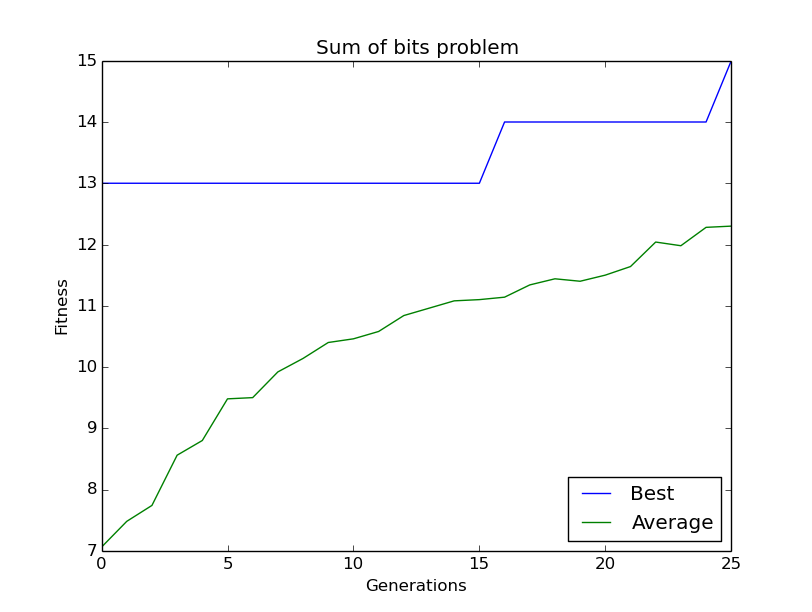
setup63 to create a git
repository for the lab. If you want to work alone do:
setup63 labs/03 noneIf you want to work with a partner, then one of you needs to run the following while the other one waits until it finishes.
setup63 labs/03 partnerUsernameOnce the script finishes, the other partner should run it on their account.
cd ~/cs63/labs/03 cp -r ~meeden/public/cs63/labs/03/* ./This will copy over the starting point files for this lab.
git add * git commit -m "lab3 start" git push
cd ~/cs63/labs/03 git pull
A genetic algorithm is an abstract simulation of some of the key ideas from biological evolution. Initially a population of candidate solutions is randomly generated. Then evolution proceeds as a sequence of generations. In each generation, the fitness of every candidate solution in the population is determined. Next, parents are selected from the population based on their fitness. With some probability, a crossover operation is done on these parents. Crossover is a simple model of sexual reproduction that recombines the candidate solutions of two parents to produce two children. Finally, with some probability, mutation may occur on each child's candidate solution. In this way, a new population is produced on each generation. Over many generations, the average fitness of the population tends to increase and more highly fit candidate solutions are created.
You have been given a skeleton definition of a GeneticAlgorithm class that you will complete. Then you will test the completed genetic algorithm on a simple problem of finding candidate solutions that maximize the sum of their values.
Once you are convinced that the genetic algorithm is working properly, you will then apply it to the more interesting problems N-Queens and finding Pacman paths in an open maze.
Open the file ga.py. Read through the methods that you will need to implement. Build your implementation incrementally, testing each new set of methods as you go.
To test them, write a main program that creates an instance of the SumGA class where the length of the candidate solutions is 10 and the population size is 20. Then call the methods that you implemented. Next, add a for loop to print out each member of the population, and its fitness. Finally, print out the class variables you created to track the best ever fitness and best ever candidate solution. Ensure that they have been set correctly based on your initial population.
spin = random() * totalFitness
partialFitness = 0
for i in the indices of each individual in the population:
# use the fitness list you created in evaluatePopulation
partialFitness += fitnessOfIndividual[i]
if partialFitness >= spin:
break
return a COPY of individual[i]
Test that your selection operator is working correctly. Use a loop to
repeatedly select members of the population. Check that the most fit
members are getting selected more often than the least fit members.
0 1 2 3 4 5 6 7
parent1: [1, 1, 1, 0, 0, 0, 0, 0]
parent2: [0, 1, 0, 1, 0, 1, 0, 1]
^
crossPoint: 3
child1: [1, 1, 1, 1, 0, 1, 0, 1]
child2: [0, 1, 0, 0, 0, 0, 0, 0]
Test that your crossover method is working properly by printing out
the parents, the selected crossover point, and the resulting children.
child before mutation: [1, 1, 1, 1, 0, 1, 0, 1] child after mutation: [1, 0, 1, 1, 0, 1, 1, 1]Because the child is represented as a list, any change you make will be permanent, so this method does not need to return anything.
initialize the newPopulation to an empty list loop until the size of newPopulation >= the desired popSize select parent1 select parent2 child1, child2 = crossover(parent1, parent2) mutate child1 mutate child2 add child1 and child2 to the newPopulation if size of newPopulation is > desired popSize randomly choose one child to remove population = newPopulation increment generation counter
Test this method and see if the average fitness of the next population is higher than the average fitness of the previous population.
set class variables given in parameters initialize a random population evaluate the population while generation < maxGeneration and optimal solution not found run one generation evaluate the population return the best ever individual and best ever fitness

The above graph was made using the pylab library. You may use this or any other graphing library you prefer. The example graph was made using the pylab functions listed below:
To read the documentation on these functions do the following:
python >>> import pylab >>> help(pylab.plot) ...
Now it is time to test whether you can evolve a solution of all 1's using the SumGA class. In your main program, create an instance of this class with candidate solutions of length 15 and a population of size 50. Perform evolution with a maximum generation of 50, a 60% chance of crossover, and a 1% chance of mutation.
If you cannot consistently evolve a solution of all 1's, then there may be a problem with your genetic operators or with your methods that control the evolutionary process. On average, my implementation finds a solution to this problem in about 22 generations.
Open the file nqueens.py and read through the implementation of the NQueens class. The constructor allows you to create an N-Queens board in two ways. For our GA, we will be passing in a list of column positions for each queen. The length of the given list will determine the size of the board. If you execute this file, you will see that several boards of different sizes are created, printed, and the number of safe queens is also printed.
The NQueensGA class has been defined for you. Each candidate solution will be a list of integers in the range 0 to the length of the list minus one. The fitness method takes a given candidate solution and creates an instance of the NQueens class, and then returns the number of safe queens on the board as the fitness. The isDone method returns True when the fitness of the best individual matches the length of the candidate solutions.
In your main program, create an instance of the NQueensGA class with candidate solutions of length 8 and a population of size 75. Perform evolution with a maximum generation of 200, a 60% chance of crossover, and a 10% chance of mutation. Notice that the mutation rate has been increased. For this problem a higher mutation rate is necessary for success. There may be runs where your GA is unable to find the optimal solution, however, it should be successful most of the time.
For this problem, you will be evolving a fixed-length list of actions (where each actions is 'North', 'South', 'East', or 'West'). Pacman will be using the maze called smallOpen that has dimensions 10x5. This maze is completely open, and is full of food. Pacman will be given at most 50 actions to try to maximize his score. If any of his actions lead him into a wall, then his trial will end immediately.
The PacmanGA has been defined for you. The fitness method takes a candidate solution (i.e. a list of 50 actions), and sends them to a ListAgent that executes them in the smallOpen maze with graphics turned off. By turning graphics off we can significantly speed up the running time of the GA. Pacman will invariably run into a wall at some point, which raises an exception for an illegal action. His score will be returned and used as the fitness for that candidate solution.
In your main program, use the following code to set up the evolution for Pacman.
global args args = pacman.readCommand( sys.argv[1:] ) args['catchExceptions'] = True # turn graphics off during evolution origDisplay = args['display'] args['display'] = textDisplay.NullGraphics() gameGA = PacmanGA(50, 50, ['North', 'South', 'East', 'West']) bestChromo, bestScore = gameGA.evolve(50, 0.6, 0.01) # turn graphics on to test the best path found args['display'] = origDisplay args['pacman'] = ListAgent(actions = bestChromo) games = pacman.runGames( **args ) print "\nBest Chomosome found:" print bestChromo print "Best Score:", bestScore
My implementation typically finds a best path with a score close to 300. Try experimenting with the parameters of the GA to see if you can consistently get better scores. Adjustments to try:
Finally, create a main program that provides a menu (as shown below), allowing you to run the problem of your choice. After each run, your program should plot the average and best fitness scores for that run.
Genetic Algorithm Select problem type 1: Sum of bits 2: N-Queens 3: Pacman Enter choice: 1
ga.py.
cd ~/cs63/labs/03 git add ga.py git commit -m "the latest version" git push